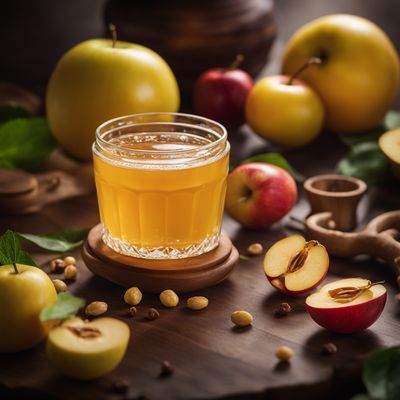
Ingredient
Nectar, apricot
The Golden Elixir: Unveiling the Delights of Apricot Nectar
Apricot nectar is a luscious and velvety liquid with a vibrant golden hue. It is made by extracting the juice from ripe apricots, resulting in a smooth and slightly thick consistency. The nectar boasts a delightful balance of sweetness and tanginess, with a distinct apricot flavor that is both refreshing and aromatic. Its texture is smooth and velvety, making it a delightful addition to beverages, desserts, and savory dishes.
Origins and history
Apricots are believed to have originated in China, where they have been cultivated for over 4,000 years. From there, they spread to other parts of Asia, including Persia (modern-day Iran), and eventually reached Europe through trade routes. Apricots were highly valued in ancient Persia and were even considered an aphrodisiac. The fruit made its way to the Mediterranean region and was introduced to the Americas by Spanish explorers in the 18th century.
Nutritional information
Apricot nectar is a rich source of vitamins A and C, providing essential antioxidants that support immune function and promote healthy skin. It is also a good source of dietary fiber and contains natural sugars. A 1-cup serving of apricot nectar typically contains around 150 calories.
Allergens
Apricot nectar may pose a risk to individuals with allergies to stone fruits, such as peaches or cherries.
How to select
When selecting apricot nectar, opt for brands that use high-quality apricots and minimal additives. Look for nectars that are made from 100% pure apricot juice without added sugars or artificial flavors. Check the expiration date to ensure freshness.
Storage recommendations
To maintain the freshness and quality of apricot nectar, store it in a cool, dark place away from direct sunlight. Once opened, refrigerate the nectar and consume it within a week.
How to produce
While producing apricot nectar on a commercial scale requires specialized equipment, amateur enthusiasts can make their own by blending ripe apricots with a small amount of water and straining the mixture to remove any solids.
Preparation tips
Apricot nectar can be enjoyed as a refreshing beverage on its own, or it can be used as a base for cocktails, smoothies, and mocktails. It also adds a delightful touch to desserts like fruit salads, sorbets, and ice creams. For savory dishes, apricot nectar can be used as a glaze for roasted meats or as a flavor enhancer in marinades and sauces.
Substitutions
If apricot nectar is not available, peach nectar or mango nectar can be used as suitable substitutes, offering a similar fruity sweetness.
Culinary uses
Apricot nectar is commonly used in a variety of culinary applications. It can be enjoyed as a refreshing drink, used as a base for cocktails and mocktails, incorporated into desserts, or used as a glaze for meats.
Availability
Apricot nectar is commonly available in regions where apricots are cultivated, such as Central Asia, the Mediterranean, and parts of North America.
More ingredients from this category

Nectar, peach
The Golden Elixir: Exploring the Sweetness of Peach Nectar

Nectar, banana
The Golden Elixir of Bananas

Nectar, apple
The Sweet Essence of Apple Nectar

Nectar, pear
The Sweet Symphony of Pear Nectar

Mixed fruit nectars
A Symphony of Fruity Delights: Exploring Mixed Fruit Nectars

Nectar, orange
"The Citrus Elixir: Exploring the Vibrant World of Orange Nectar"

Nectar, pineapple
"Tropical Delight: Exploring the Vibrant World of Pineapple Nectar"

Nectar, mango
The Golden Elixir of Mango Nectar